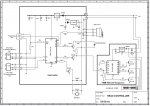Hi All,
Im looking for some suggestions on ways to measure the passing of an object through a gap of say 1m. However, I want to so that it can tell which direction that object has traveled. The gap between the sensors is to be no more than 110mm apart, but ideally would be 30mm aprat.
My current idea is to use two IR sensors, mounted in tubes to limit their angle of detection. Then using a picaxe to measure which IR is set off first, that way determining which direction the object has traveled.
I was just wondering if this is the most efficient and accurate method (that doesn't cost the earth)
Many thanks
Russ
Im looking for some suggestions on ways to measure the passing of an object through a gap of say 1m. However, I want to so that it can tell which direction that object has traveled. The gap between the sensors is to be no more than 110mm apart, but ideally would be 30mm aprat.
My current idea is to use two IR sensors, mounted in tubes to limit their angle of detection. Then using a picaxe to measure which IR is set off first, that way determining which direction the object has traveled.
I was just wondering if this is the most efficient and accurate method (that doesn't cost the earth)
Many thanks
Russ

